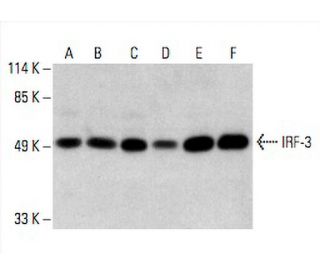
IRF3 Antikörper (SL-12): sc-33641
- IRF3 Antikörper SL-12 ist ein Maus monoklonales IgG1 κ IRF3 Antikörper, verwendet in 86 wissenschaftlichen Veröffentlichungen, in einer Menge von 200 µg/ml
- gegen rekombinantes IRF-3 Fusionsprotein entsprechend human IRF-3 (Aminosäuren 56-427)
- IRF3 Antikörper (SL-12) ist empfohlen für die Detektion von IRF-3 aus der Spezies mouse, rat und human per WB, IP, IF und IHC(P)
- Anti-IRF3 Antikörper (SL-12) ist erhältlich als Konjugat mit Agarose für IP; HRP für WB, IHC(P) und ELISA; und entweder mit Phycoerythrin oder FITC für IF, IHC(P) und FCM
- auch erhältlich als Konjugat mit Alexa Fluor® 488, Alexa Fluor® 546, Alexa Fluor® 594 oder Alexa Fluor® 647 für IF, IHC(P) und FCM
- auch erhältlich als Konjugat mit Alexa Fluor® 680 oder Alexa Fluor® 790 für WB (NIR), IF und FCM
- erhältlich als TransCruz Reagenz für Gel Supershift und ChIP (sc-33641 X, 200 µg/0.1 ml)
- m-IgG Fc BP-HRP und m-IgG1 BP-HRP sind die bevorzugten sekundären Nachweisreagenzien für IRF3 Antikörper (SL-12) for WB and IHC(P) applications. Diese Reagenzien werden jetzt in Bündeln mit IRF3 Antikörper (SL-12) angeboten(siehe Bestellinformationen unten).
Der IRF-3-Antikörper (SL-12) ist ein monoklonaler IgG1-Antikörper der leichten Kette von Mäusen, der mit außergewöhnlicher Präzision auf das Protein Interferon Regulatory Factor 3 (IRF-3) abzielt. Der gegen ein rekombinantes IRF-3-Fusionsprotein, das dem menschlichen IRF-3 (Aminosäuren 56-427) entspricht, entwickelte Anti-IRF-3-Antikörper (SL-12) erkennt IRF-3 von Mäusen, Ratten und Menschen zuverlässig in einer Vielzahl von Anwendungen, darunter Western Blotting (WB), Immunopräzipitation (IP), Immunfluoreszenz (IF) und Immunhistochemie mit in Paraffin eingebetteten Schnitten (IHCP). IRF-3, auch als IIAE7 bezeichnet, ist ein entscheidender Transkriptionsfaktor in der angeborenen Immunantwort, der eine wichtige Rolle bei der Erkennung von Virusinfektionen und der anschließenden Aktivierung von Typ-I-Interferonen wie IFN-β spielt. Bei einer Virusinfektion wird IRF-3 phosphoryliert, dimerisiert und wandert in den Zellkern, wo IRF-3 an spezifische DNA-Elemente bindet, um die Transkription von Interferongenen zu initiieren und so einen robusten antiviralen Abwehrmechanismus zu koordinieren. Das Verständnis und die Analyse der Funktion von IRF-3 ist unerlässlich, um die molekularen Signalwege zu klären, die an der Immunregulation und der Reaktion des Körpers auf Krankheitserreger beteiligt sind. Der monoklonale Antikörper IRF-3 (SL-12) ist sowohl in nicht konjugierter Form als auch in einer Vielzahl konjugierter Formen erhältlich, darunter Agarose, Meerrettichperoxidase (HRP), Phycoerythrin (PE), Fluoresceinisothiocyanat (FITC) und mehrere Alexa Fluor®-Konjugate. Damit stehen Forschern vielseitige Werkzeuge zur Verfügung, um die komplexen Rollen von IRF-3 in zellulären Prozessen und Krankheitszuständen zu untersuchen.
Alexa Fluor® ist ein Markenzeichen von Molecular Probes Inc., OR., USA
LI-COR® und Odyssey® sind Markenzeichen von LI-COR Biosciences
IRF3 Antikörper (SL-12) Literaturhinweise:
- Auslösung der Interferon-Reaktion: die Rolle des Transkriptionsfaktors IRF-3. | Hiscott, J., et al. 1999. J Interferon Cytokine Res. 19: 1-13. PMID: 10048763
- Überlappende und unterschiedliche Mechanismen zur Regulierung der IRF-3- und IRF-7-Funktion. | Servant, MJ., et al. 2002. J Interferon Cytokine Res. 22: 49-58. PMID: 11846975
- Kontrolle der IRF-3-Aktivierung durch Phosphorylierung. | Yoneyama, M., et al. 2002. J Interferon Cytokine Res. 22: 73-6. PMID: 11846977
- Identifizierung und Charakterisierung von MAVS, einem mitochondrialen antiviralen Signalprotein, das NF-kappaB und IRF 3 aktiviert. | Seth, RB., et al. 2005. Cell. 122: 669-82. PMID: 16125763
- Der Kinase-Komplex, der für die IRF-3-vermittelte IFN-beta-Produktion in myeloiden dendritischen Zellen (mDC) verantwortlich ist. | Sasai, M., et al. 2006. J Biochem. 139: 171-5. PMID: 16452304
- Unterschiedliche Funktionen von IRF-3 und IRF-7 bei der IFN-alpha-Genregulation und der Kontrolle der Antitumoraktivität in primären Makrophagen. | Solis, M., et al. 2006. Biochem Pharmacol. 72: 1469-76. PMID: 16846591
- IRF-3-abhängige und verstärkte Zielgene während einer Virusinfektion. | Andersen, J., et al. 2008. Genes Immun. 9: 168-75. PMID: 18094709
- Die Rolle von IRF-3 und IRF-7 bei der angeborenen antiviralen Immunität gegen das Dengue-Virus. | Chen, HW., et al. 2013. J Immunol. 191: 4194-201. PMID: 24043884
- Thymochinon unterdrückt die IRF-3-vermittelte Expression von Typ-I-Interferonen durch Unterdrückung von TBK1. | Aziz, N., et al. 2018. Int J Mol Sci. 19: PMID: 29751576
- Die strukturelle Grundlage der IRF-3-Aktivierung nach Phosphorylierung. | Jing, T., et al. 2020. J Immunol. 205: 1886-1896. PMID: 32826280
Bestellinformation
| Produkt | Katalog # | EINHEIT | Preis | ANZAHL | Favoriten | |
IRF3 Antikörper (SL-12) | sc-33641 | 200 µg/ml | RMB2377.00 | |||
IRF3 (SL-12): m-IgG Fc BP-HRP Bundle | sc-526695 | 200 µg Ab; 10 µg BP | RMB2662.00 | |||
IRF3 (SL-12): m-IgG1 BP-HRP Bundle | sc-532068 | 200 µg Ab; 20 µg BP | RMB2662.00 | |||
IRF3 Antikörper (SL-12) X | sc-33641 X | 200 µg/0.1 ml | RMB2377.00 | |||
IRF3 Antikörper (SL-12) AC | sc-33641 AC | 500 µg/ml, 25% agarose | RMB3129.00 | |||
IRF3 Antikörper (SL-12) HRP | sc-33641 HRP | 200 µg/ml | RMB2377.00 | |||
IRF3 Antikörper (SL-12) FITC | sc-33641 FITC | 200 µg/ml | RMB2482.00 | |||
IRF3 Antikörper (SL-12) PE | sc-33641 PE | 200 µg/ml | RMB2580.00 | |||
IRF3 Antikörper (SL-12) Alexa Fluor® 488 | sc-33641 AF488 | 200 µg/ml | RMB2685.00 | |||
IRF3 Antikörper (SL-12) Alexa Fluor® 546 | sc-33641 AF546 | 200 µg/ml | RMB2685.00 | |||
IRF3 Antikörper (SL-12) Alexa Fluor® 594 | sc-33641 AF594 | 200 µg/ml | RMB2685.00 | |||
IRF3 Antikörper (SL-12) Alexa Fluor® 647 | sc-33641 AF647 | 200 µg/ml | RMB2685.00 | |||
IRF3 Antikörper (SL-12) Alexa Fluor® 680 | sc-33641 AF680 | 200 µg/ml | RMB2685.00 | |||
IRF3 Antikörper (SL-12) Alexa Fluor® 790 | sc-33641 AF790 | 200 µg/ml | RMB2685.00 |
